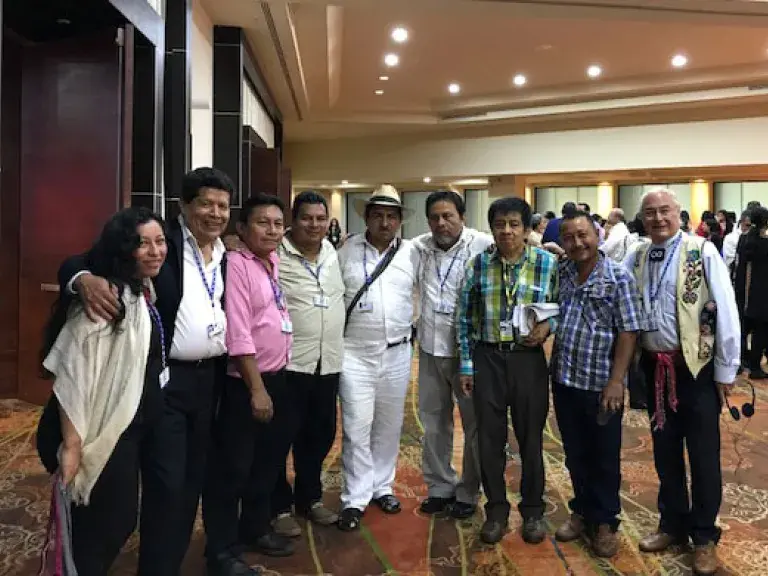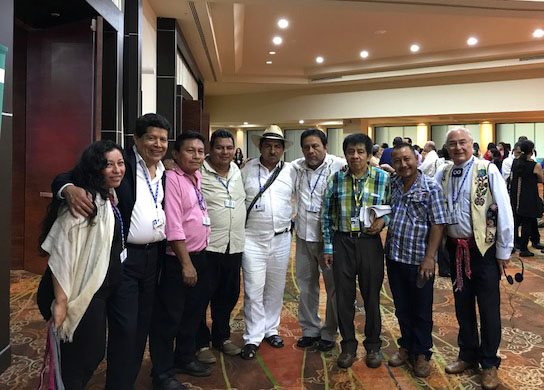
 June 20, 2017 (Español) | Indigenous leaders are in Cancun, Mexico, this week calling on the Organization of American States (OAS) to take action during its 47th General Assembly to implement the promises in the American Declaration on the Rights of Indigenous Peoples, adopted June 15, 2016. The American Declaration offers specific protection for indigenous peoples in North America, Mexico, Central and South America, and the Caribbean.
June 20, 2017 (Español) | Indigenous leaders are in Cancun, Mexico, this week calling on the Organization of American States (OAS) to take action during its 47th General Assembly to implement the promises in the American Declaration on the Rights of Indigenous Peoples, adopted June 15, 2016. The American Declaration offers specific protection for indigenous peoples in North America, Mexico, Central and South America, and the Caribbean.
“The Declaration can and should ensure the permanent existence of indigenous peoples and prevent the further extinction of our languages, cultures, and lives,” said Armstrong Wiggins, director of the Indian Law Resource Center’s Washington, D.C., office. “Indigenous leaders are recommending concrete actions the OAS can take to move the implementation of the Declaration forward.”
The actions, outlined in a statement by the Indigenous Peoples and Nations Coalition during the OAS’ interactive dialogue with civil society and member states, call for a mechanism to be established within the OAS that is capable of responding to major problems or issues concerning indigenous lands and resources, protection of the environment, and the well-being and self-governance of indigenous peoples, including the health and safety of indigenous women and children.
 While the Plan of Action of the American Declaration on the Rights of Indigenous Peoples, expected to be adopted by the full OAS General Assembly, does include reviewing the possibility of creating an institutional mechanism to monitor implementation of the American Declaration, it does nothing to advance the permanent and direct participation of indigenous peoples’ governance institutions in OAS meetings and activities.
While the Plan of Action of the American Declaration on the Rights of Indigenous Peoples, expected to be adopted by the full OAS General Assembly, does include reviewing the possibility of creating an institutional mechanism to monitor implementation of the American Declaration, it does nothing to advance the permanent and direct participation of indigenous peoples’ governance institutions in OAS meetings and activities.
“The Plan is an important first step,” said Wiggins. “We hope through continued dialogue, more of the recommendations by indigenous leaders will help shape the plan in the future.”
Indigenous leaders also called on the Inter-American human rights system, both the Commission and the Court, to present dedicated annual reports on the actions taken to promote and protect the rights of indigenous peoples. In addition, indigenous leaders called for a special high-level conference to consult with indigenous peoples and members states on how best to implement and achieve the objectives of the Declaration.
The American Declaration now stands as one of the most important instruments of the Inter-American human rights system. Both the Commission and the Court will interpret the Declaration to provide context to other instruments, such as the American Convention on Human Rights – the main regional human rights treaty – and the American Declaration on Rights and Duties of Man. This is particularly important when indigenous peoples are seeking recognition of treaty and land rights, protections for those in voluntary isolation or under internal armed conflicts, and protections for indigenous women, children, and families.
The Indian Law Resource Center has participated in all of the negotiations on the development of the American Declaration to provide legal advice and support to indigenous representatives. The OAS is a regional intergovernmental organization of 35 member countries of the Americas, including the United States.
Visit www.indianlaw.org to learn more about the Center’s work on the American Declaration on the Rights of Indigenous Peoples.
